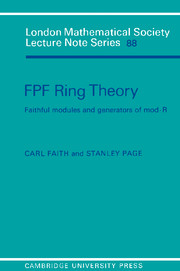Book contents
- Frontmatter
- Contents
- Preface
- Dedication and Acknowledgement
- Introduction
- Chapter 1 The Basics
- Chapter 2 Noncommutative Semiperfect and Semiprime
- Chapter 3 Nonsingular FPF rings
- Chapter 4 Goldie Prime FPF Rings with RRM and the Structure of Noetherian Prime FPF Rings
- Chapter 5 Self-Injective FPF Rings, Thin Rings and FPF Group Rings
- Summary of the Structure of FPF Rings
- Open Questions
- Bibliography
- Abbreviations and Symbols
- Index
Chapter 2 - Noncommutative Semiperfect and Semiprime
Published online by Cambridge University Press: 05 April 2013
- Frontmatter
- Contents
- Preface
- Dedication and Acknowledgement
- Introduction
- Chapter 1 The Basics
- Chapter 2 Noncommutative Semiperfect and Semiprime
- Chapter 3 Nonsingular FPF rings
- Chapter 4 Goldie Prime FPF Rings with RRM and the Structure of Noetherian Prime FPF Rings
- Chapter 5 Self-Injective FPF Rings, Thin Rings and FPF Group Rings
- Summary of the Structure of FPF Rings
- Open Questions
- Bibliography
- Abbreviations and Symbols
- Index
Summary
This chapter contains results on the right FPF rings which are semiperfect. The semiperfect rings have two properties which facilitate the inquiry: I) They have a basic ring and primitive idempotents, II) The Krull-Schmidt theorem holds for direct sums of principal indecomposables. The first theorem states that any semiperfect right FP2F (or FP2 F) ring R is a direct sum of uniform right prindecs (= principal indecomposable right ideals), the basic ring RO is strongly right bounded (Compare Theorem 1.7B: any right PF ring has basic ring R0 which is strongly bounded on both sides) and is a direct summand of every finitely generated (presented) faithful right module. Moreover, if R or R/rad R is prime, then R is a full matrix ring R0 over a n local ring prime right (Corollaries A which is right FPF (FP 2F) and if R is FPF, then A is a two-sided valuation domain 2.lC and 2.11E).
A semiperfect right self-injective ring R with strongly right bounded basic ring is right FPF (Theorem 2.2), moreover, the converse holds provided that for each right prindec eR, every element of e(radR)e is a zero divisor of eRe, e.g. if rad R is nil (Corollary 2.2B). Although in general the basic ring of a semiperfect FPF ring is not a product of local rings, that of any semiperfect right CFPF ring R is. (See Theorem 2.5, and 2.7 for a converse.)
- Type
- Chapter
- Information
- FPF Ring TheoryFaithful Modules and Generators of Mod-R, pp. 41 - 57Publisher: Cambridge University PressPrint publication year: 1984

